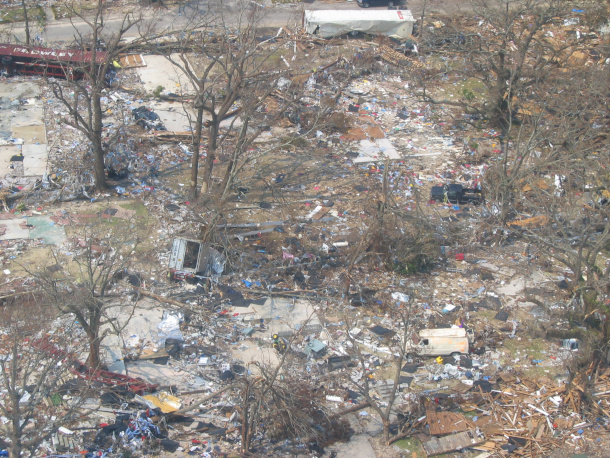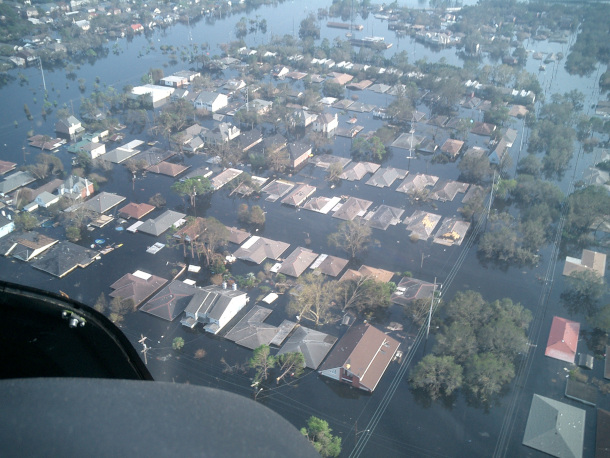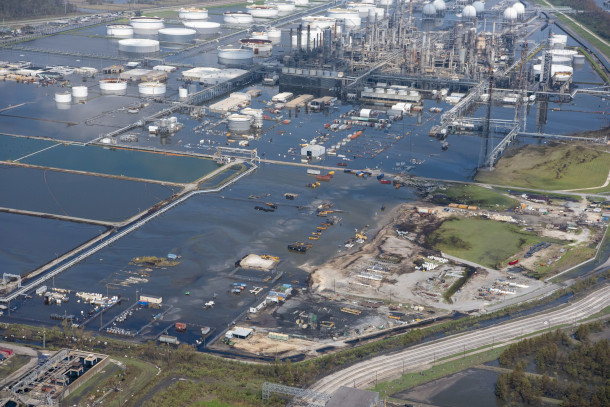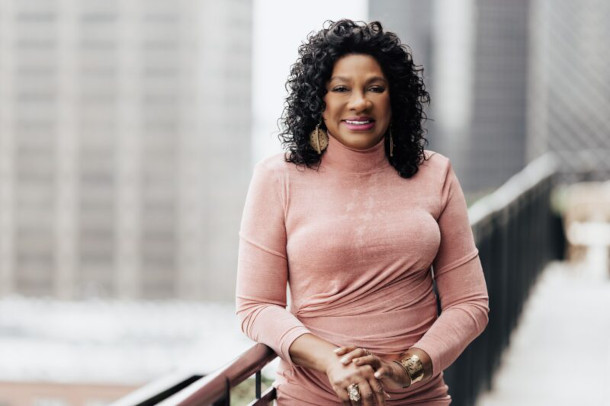The Quest for Climate Justice
Air Date: Week of April 1, 2022

Hurricane Katrina was a large and destructive Category 5 Atlantic hurricane that caused over 1,800 fatalities and $125 billion in damage in late August 2005 when it came ashore in the Gulf Coast. Even though wind speeds had slowed down when Katrina hit New Orleans failures in the levee system and pumping stations compounded the disaster. Photo: News Muse, Flickr, CC BY-NC-ND 2.0)
President Biden’s “Justice 40” initiative aims to deliver federal investments in climate protection and clean energy production to disadvantaged communities in places including the Gulf Coast. Communities of color there are disproportionately impacted by climate change and industrial pollution and appear to not receive as much support to rebuild after hurricanes as white communities. Beverly Wright, the Executive Director for the Deep South Center for Environmental Justice and a member of the White House Environmental Justice Advisory Council, joined Host Steve Curwood to talk about race and President Biden's Justice 40 initiative.
Transcript
CURWOOD: Shortly after taking office President Biden launched his “Justice 40” initiative which aims to deliver to disadvantaged communities 40 percent of the benefits of federal investments in climate protection and clean energy production. Justice 40 is a step towards supporting the communities often most impacted by climate change but with the least resources to adapt. The Gulf Coast is a prime example. Hurricane Katrina, fueled by a warming ocean, leveled parts of poorly protected New Orleans and since then another 10 hurricanes have hit the region. Beverly Wright says communities of color are not being supported to rebuild in the same way as white communities. She is the founder and Executive Director for the Deep South Center for Environmental Justice as well as a member of the White House Environmental Justice Advisory Council that’s working to fulfill President Biden’s Justice 40 initiative. Beverly Wright, Welcome back to Living on Earth!
WRIGHT: Thank you, Steve. Great to see you again. It's been a long time.
CURWOOD: It has Dr. Wright. And it's been some 17 years since Hurricane Katrina hit Louisiana and exposed deep environmental justice issues. Tell me about what progress has been there so far.
WRIGHT: Well, as is always the case, you know, we've made steps forward and we've made steps backwards. We've lost population, mainly because of the infrastructure not being in the shape it needs to be in for people to return. We've had gentrification at warp speed. Whole neighborhoods that were formerly historically Black being gentrified at a rate that's unbelievable. Even Treme where Louis Armstrong grew up, you now see white people walking everywhere and black people displaced. They've been pushed out to the New Orleans suburb, New Orleans East where I live, in a place where there are no amenities for them, no bus service, that will allow them to get back in town to work. So New Orleans people are resilient and in spite of everything that's been here to deter are remaining, including climate change, which is kicking our butts. Last year, we had five hurricanes in one year. And right now it's trying to recover from Ida, that's the latest hurricane that hit our city. You compound that with insurance rates going through the roof. So we're in a conundrum. We're in a conundrum because of the oil industry and its impact on climate change. Because the oil industry produces PM 2.5, which is a air pollutant and so our mortality rate was higher than others, due to COVID and it had everything to do with air pollution. So if I wanted to talk about some lessons learned, there are some huge lessons that we're learning.
CURWOOD: By the way, what happened to the money became for recovery funding after Katrina? What happened when it came to black and white neighborhoods there in New Orleans?

When Hurricane Katrina hit Southeast New Orleans on August 29, 2005, Category 1 range winds and storm surges caused approximately 23 breaches in the drainage canal and navigational canal levees and floodwalls. (Photo: News Muse, Flickr, CC BY-NC-ND 2.0)
WRIGHT: Okay, well, my center actually did a study of where the money went. So the city of New Orleans probably has gone through more design charettes, than any other city in the United States. And we came together to talk about how we wanted our city to recover and what development projects should we put in place. Well, when we looked at where the money was spent and compared that by each wards of the city, what we found was that the only wards that got what they wanted, were the wards that were wealthy white people and the downtown district. The communities that were hurt the most, got only a very small portion of the monies for recovery. And there's some other really strong data that came out that ended up in a lawsuit where the Road Home Project actually gave more monies to white people to rebuild their homes than they did to black people. And that was certainly connected to systemic racism, because they devalued our homes because of the formula that was put in place. And let me explain what that formula was, the formula said that you would get monies based on the lesser of two variables, that is the cost to rebuild your house and the assessed value of your house. And so the assessed value of the same house in a black neighborhood, versus a white neighborhood was many thousands of dollars off. So if you were given the amount of money for the assessed value of your house, that didn't change the cost to rebuild your house, whereas white communities had their assessed value, and the cost to rebuild being the same, whereas we did not. That meant that large numbers of black people in this city did not get enough money to rebuild their homes. We sued. We sued the Road Home Project and won. But you know what happens when you sue and win we had to get the judges to stop the spending of the money because all the money would've been gone. But what was left certainly was not enough to repair the damages that had been done. So you get that consent decree. And it's like, you know, do the wrong thing. You know, it's wrong, wait to be told not to do it. And then you go into some consent decree based on the amount of money left.
CURWOOD: Beverly Wright let's talk about the Infrastructure Investment and Jobs Act sometimes called the Bipartisan Infrastructure Bill that President Biden signed last year. And now White House will say this is a great chance to have transformational environmental legislation go to work. What does the Deep South Center for Environmental Justice support in the bipartisan infrastructure framework and for that matter, the Biden administration accomplishments so far?
Biden wants to spend infrastructure billions on climate and equity initiatives. But it’s not his call..https://t.co/4ZDSxsAWHr @politico #Justice40
— Robert D. Bullard (@DrBobBullard) March 25, 2022
WRIGHT: Well, I'm of mixed emotions on the bipartisan infrastructure bill. I think overall, you know, it's a really smart attempt at transforming this country, from fossil fuels to renewable energy. I think that our biggest concern is implementation, how these dollars are going to be spent. While the bill itself is a great bill, you know, we'd like to see more money be placed on what we call legacy communities, communities that are built on top of superfund sites. And if we're talking about transformation or transforming to renewable energy, this is a wonderful place to begin moving people off of these toxic land, building the land back up to a level for industrial use and putting some of planet fields, solar fields on those lands. And there's no limit to the wonderful ideas that we are pushing forward for this transformation process, but we always think about implementation. The Environmental Career Worker Training Program that exists for example, at NIHS is a great program that teaches young people, it trains them in hazardous waste worker field, with remediation of lead and asbestos and all of these things. That same program now we're trying to advance to include training in the construction of solar panels, and hydro, and wind. Making certain that our populations are trained to meet the challenges of this new renewable society that we're trying to move into. And we're prepared for the enormous amount of jobs and wealth that could come with that training.
CURWOOD: And let me ask you about the White House Environmental Justice Advisory Council. WHEJAC is what it's known as. What's the purpose of it, and what has it accomplished so far?
WRIGHT: So the White House Environmental Justice Advisory Council had three main objectives, we were given three objectives. The first was the implementation of Justice 40, the development of what we call a scorecard, that is to be able to judge whether or not the different agencies were meeting the 40% goal that is 40% of benefits for any renewable projects going to EJ and climate impacted communities. We're supposed to also develop a screening tool that would be the tool that's used to define the communities that should benefit from the Justice 40 implementation. And the fourth was to strengthen the Executive Order 12898. And one of our problems is that this particular factor falls under CEQ. CEQ (Council on Environmental Quality) has about maybe 10 People working in that office to implement a nationwide plan. And so they're terribly underfunded and working on the WHEJAC, we find that we are under resourced. And we have no contractors. We're all doing this on our own.

The Coast Guard conducts an overflight of a flooded oil refinery for potential pollution threats and environmental impacts from Hurricane Ida Sept. 3, 2021, in Belle Chasse, Louisiana. (Photo: Petty Officer 2nd Class Ryan Dickinson, U.S. Coast Guard, Flickr, CC BY-NC-ND 2.0)
CURWOOD: CEQ stands for the Council on Environmental Quality, the White House Council on Environmental Quality?
WRIGHT: Yes.
CURWOOD: That's what you're referring to. 10 people work there. Only 10 people work there?
WRIGHT: Yeah, it's a very small staff. And it has been overwhelming for them. You know, and needless to say, the workload for us is quite amazing. And so I believe that at this point, we're taking a new look at, you know, the weight, the organizational structure of our work in relation to CEQ. Making suggestions about how we should reorganize this, put more resources and people into this process. And there's a game plan already in existence that could be utilized and and it's certainly one that the federal government uses in other spaces.
CURWOOD: Beverly Wright talk to me about the Gulf Coast region. I mean, your part of America has seen environmental disaster after catastrophe after disaster and of course, the toxic pollution from the petrochemical industry there, especially in the Lower Mississippi, but then of course out into the Gulf of Mexico. What opportunity does the Biden administration have to change that?
WRIGHT: Oh, wow. Well, I you know, if all people in this country was seen as equal a lot of the stuff that we've done, we would do differently. In other words, there would be no Cancer Alley per se, because we would have moved forward more carefully to protect the health of our citizens. We've done a good job of trying to protect the health of some people making certain that their environment is clean, making certain that nothing nasty or dirty goes in certain places where certain people live. Imagine what a different world it would be if in fact, we did things differently. So I think that President Biden has, in so many ways, talked about environmental justice and making certain that that is at the forefront of many of his speeches and even parts of his platform. But finding a way to implement all of the unbelievable projects that he has put in place, is still now in danger of not happening because of racism. And you take a simple thing like in the screening tool, not allowing race to be a factor. So the whole reason for Justice 40 is because of race. The racially disproportionate impacts of environmental pollution and climate change on communities because of their race. But then he puts a program in place to deal with that, but you can't use race as a factor. So we're left to turn ourselves into pretzels, trying to find other ways to make certain that Black people in particular are included in the screening tool. So you come up with something like linguistics, great, but that doesn't affect Black people. Even when you use income, you know, middle and upper income Black people breathe more pollution than a white person that that earns $10,000 a year. So the income variable is blown. But once again, the lawyers step in and you know, they say, because there's money attached to this, you cannot use race as a reason to put monies into programs. So we're forced again in this racist society to deal with racist ideologies that stop us from really dealing with the race problem.

Beverly Wright is the founder and Executive Director for the Deep South Center for Environmental Justice as well as a member of the White House Environmental Justice Advisory Council. (Photo: Courtesy of the Deep South Center for Environmental Justice)
CURWOOD: Dr. Beverly Wright is the founder and executive director for the Deep South Center for Environmental Justice. Thanks so much for taking the time with us today.
WRIGHT: Thanks, Steve.
Links
Learn more about the White House Environmental Justice Advisory Council
Learn more about the Deep South Center for Environmental Justice
Watch the Second Annual Hazel Johnson EJ Celebration Featuring Dr. Beverly Wright
Living on Earth wants to hear from you!
Living on Earth
62 Calef Highway, Suite 212
Lee, NH 03861
Telephone: 617-287-4121
E-mail: comments@loe.org
Newsletter [Click here]
Donate to Living on Earth!
Living on Earth is an independent media program and relies entirely on contributions from listeners and institutions supporting public service. Please donate now to preserve an independent environmental voice.
NewsletterLiving on Earth offers a weekly delivery of the show's rundown to your mailbox. Sign up for our newsletter today!
 Sailors For The Sea: Be the change you want to sea.
Sailors For The Sea: Be the change you want to sea.
 The Grantham Foundation for the Protection of the Environment: Committed to protecting and improving the health of the global environment.
The Grantham Foundation for the Protection of the Environment: Committed to protecting and improving the health of the global environment.
 Contribute to Living on Earth and receive, as our gift to you, an archival print of one of Mark Seth Lender's extraordinary wildlife photographs. Follow the link to see Mark's current collection of photographs.
Contribute to Living on Earth and receive, as our gift to you, an archival print of one of Mark Seth Lender's extraordinary wildlife photographs. Follow the link to see Mark's current collection of photographs.
 Buy a signed copy of Mark Seth Lender's book Smeagull the Seagull & support Living on Earth
Buy a signed copy of Mark Seth Lender's book Smeagull the Seagull & support Living on Earth

